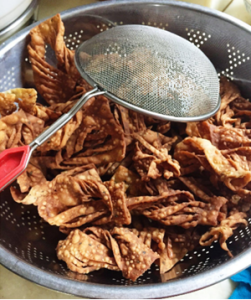Although I was born in Beijing, my ancestral hometown is in Qingdao, Shandong province. There were plenty of different street food near the neighborhood where my grandma’s house in Qingdao was when I was a little girl. Thus, back in the deep of my memory, I was simply fascinated with the snacks that I enjoyed on the street. One of them is Má Huā (Chinese: 麻花).
It is well-known that TianJin is the city which is the most famous for Má Huā, however, Má Huā is not typical to TianJin. We also have Jisan Má Huā in Shanxi province, Xianyang Má Huā in Shaanxi province and so on. Overall, it is a Han ethnic food with various flavors in different places, which is made of two or three twisted strips of dough and usually fried in peanut oil. Since it looks like hinge, it is also called “hinge stick” in Chinese (Chinese: 绞链棒).
It describes the clothes is almost torn up due to wear and tear. Má Huā can be either sweet or salty. Má Huā contains a lot of protein, vitamin and trace elements that is good for human body under its shiny golden color. Although it is fried, it is not fatty at all, so it is ideal as a kind of snacks. When it is the “Beginning of Summer” (Chinese: 立夏), there is a tradition of eating Má Huā in the Northeast area of China.

Ingredients:
Salt, Sugar, Peanut Oil, Wheat Flour, Sesame
Cooking Method:
1. Put wheat flour and peanut oil with salt and water together into a container, well mix them and wait for 20 minutes to let the dough ferment.
2. Take out the well-fermented dough and cut it into many tiny pieces of dough, and then rub each tiny dough to make it into strip shape (Depend on your personal preference, you can also add sesame and sugar into the dough when you rub it).
3. Continue to rub each strip shape dough in opposite direction and close the ends to make a raw Má Huā.
4. Put the oil into the pan and fry the Má Huā when the oil is not too hot yet.
Additional Cooking Method:
I got to know Má Huā so well because it is a tradition to my family to make Má Huā by ourselves during the Spring Festival. What is interesting is that our cooking method is different than others. We not only add sesame and sugar into the dough but also use olive oil to fry. What’s more, the way of making raw Má Huā is different than simply rub it till it becomes strip shape but we make the dough as a thin pancake and then cut it into small pieces. At last, we roll over one side of the edge and make it as a Má Huā shape.
History:
There are different histories of different type of Má Huā from different places. No one can tell for sure when and what the exact origin of Má Huā is. However, there is one among them that I find most interesting to me, which is the origin of Daying Má Huā in Henan province. It is said that at the end of Ming Dynasty, there were a lot of poisonous scorpions in Daying and many people died because of being bite by the scorpion. So the local people decided to make twisted dough which looked like the tail of scorpion and eat it after frying in order to curse the scorpion every the second day of February of Chinese lunar year. It is called “eat the tail of scorpion” (Chinese: 咬蝎尾).
Later the tradition gradually developed into making today’s Má Huā. And Má Huā thus implies fortune and happiness. Whenever there is someone either get married or pass away, the local people will give Má Huā as a gift to express their best wishes to the ones.
Interesting Point:
TianJin GuiHuaXiang ShiBaJie (Chinese: 桂发祥十八街) Má Huā is the earliest Guinness record keeper of Má Huā in China. They created the largest Má Huā in the world at that time. It was 1.5564 meters long and 24.98 kilograms weight.
Possible Variations:
Yóu Tiáo 油条
Zhá Săn Zi 炸馓子
Táng Ěr Duō 糖耳朵
Photo Credit to: https://c1.staticflickr.com/8/7340/16587403572_50a8d5432b_b.jpg
